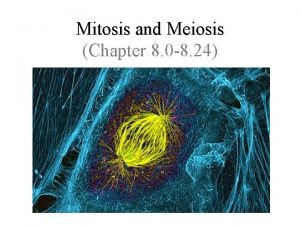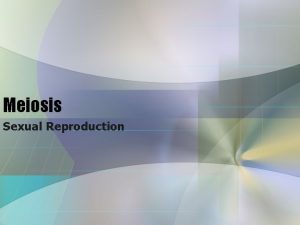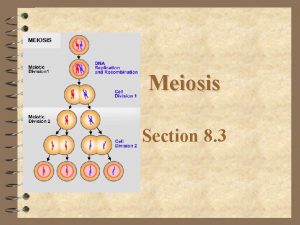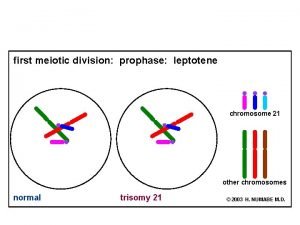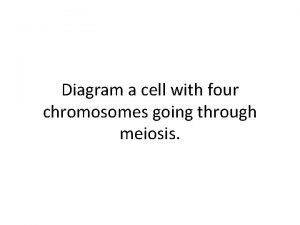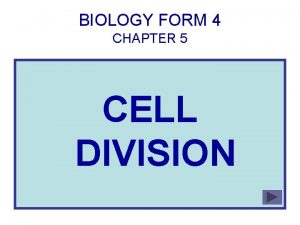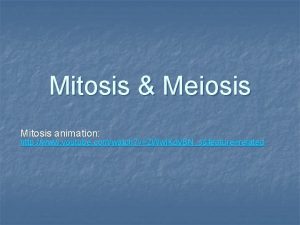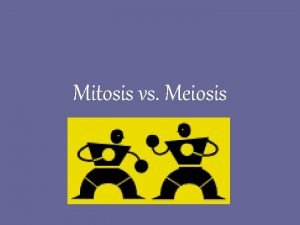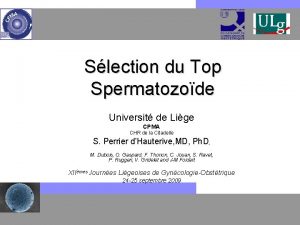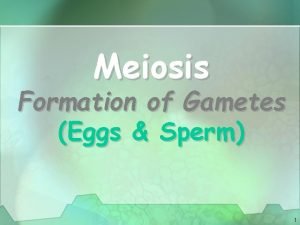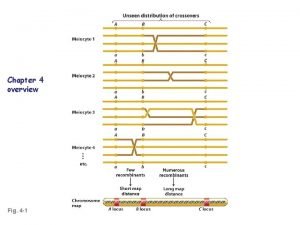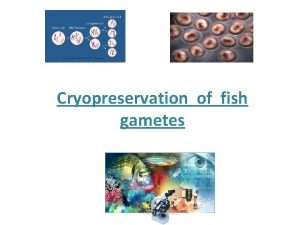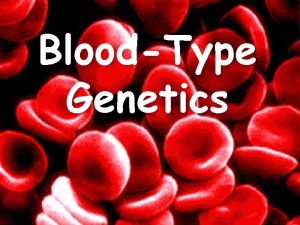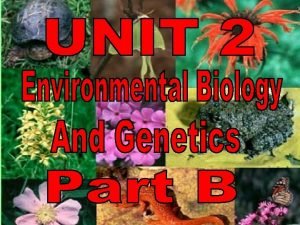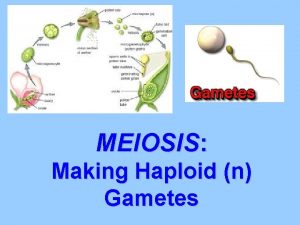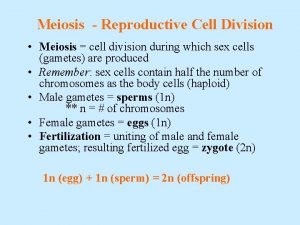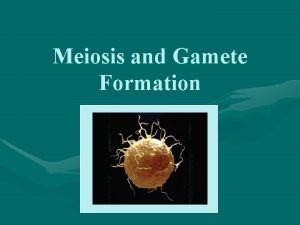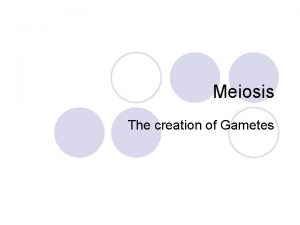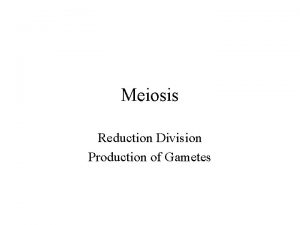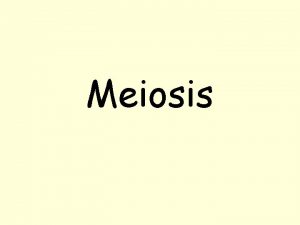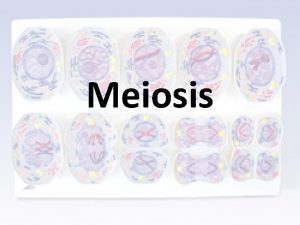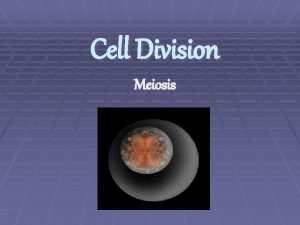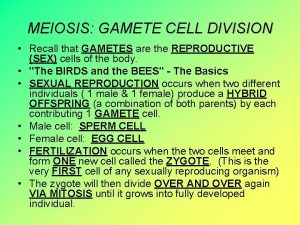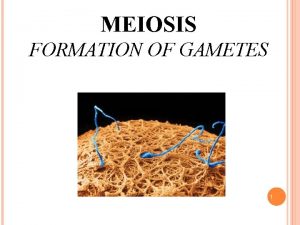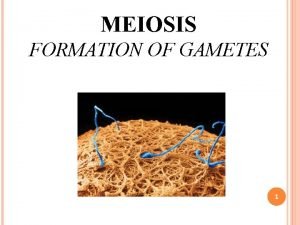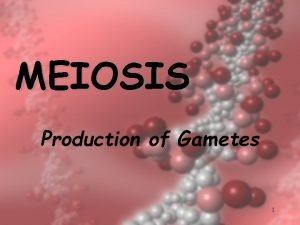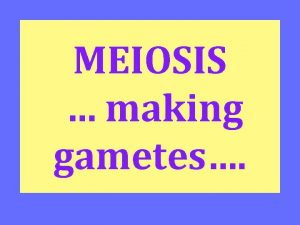MEIOSIS Cell Division to form Gametes Meiosis Animation




























- Slides: 28

MEIOSIS Cell Division to form Gametes

Meiosis: Animation CLICK HERE!

Things to remember • Genes from both parents are both in sex cells until meiosis occurs! • Meiosis results in 4 genetically different cells! So genetically different offspring result! • Half of genetic info from each parent! • The process is similar to mitosis, with a few VERY IMPORTANT NEW STEPS!

Vocabulary • Homologous Chromosomes: – Chromosomes from female parent that correspond to chromosomes from male parent. • Ex. 2 genes for eye color – 1 gene from mom (on chromosome z) – 1 gene from dad (on chromosome z)

Vocabulary con’t……. . • Diploid (2 N): – A cell that contains the full chromosome # • I. e. mitosis always STARTS and RESULTS in a diploid number (46) • I. e. meiosis always STARTS with diploid number (46) • Haploid (N): – A cell (always a gamete) that contains ½ the number of chromosomes – Meiosis results in cells with ½ number of chromosomes (23)! • Crossing-over: – Process when homologous chromosomes “cross” each other and exchange genes – Reason why you aren’t exactly like your siblings!

DRAW CROSSING OVER!

Spermatogenesis and Oogenesis • Spermatogenesis: – Formation of sperm cells – Results in 4 functional gametes • Oogenesis: – Formation of egg cells (ova) – Results in 1 functional gamete and 3 polar bodies

Gametogenesis

Basic diagram of Meiosis- Sperm 46 chromosomes Male Human Pre. Gamete Replication and Crossing-Over 46 different chromosomes 23 23 46 First cell division different chromosomes 4 functional sperm After 2 nd cell division 23 23

Basic diagram of Meiosis- Ova 46 chromosomes Female Human Pre. Gamete Replication and Crossing-Over 46 different chromosomes First cell division 1 functional ovum and 3 23 polar bodies 46 different chromosomes

Meiosis I • Interphase I – DNA copies itself • Prophase I – Chromosomes pair with their homologous partner to form a tetrad (4 chromatids) – CROSSING OVER OCCURS!!!!!!!

Meiosis I • Metaphase I – Homologous chromosomes align along middle of cell

Meiosis I • Anaphase I – Spindle fibers pull homologous chromosomes toward opposite poles

Meiosis I • Telophase I and Cytokinesis – Nuclear membranes reform – Cell separates into 2 cells

Meiosis II • Each cell still has 2 chromatids • The goal of meiosis II is to get 1 chromatid into each cell! • Prophase II – Happens very quickly – Spindle fibers appear – Nuclear membranes disappear

Meiosis II • Metaphase II – Chromatids align at middle of cells

Meiosis II • Anaphase II – Sister chromatids separate and move toward poles

Meiosis II • Telophase II and Cytokinesis – Chromatids are at opposite poles – Nuclear membranes reappear – Cells divide and result in 4 genetically different gametes that are HAPLOID!

Meiosis Square Dance link Start at 1: 35

KEYS TO MEIOSIS • Original cell has complete set of chromosomes (Diploid or 2 N) • 2 divisions result in 4 DAUGHTER CELLS (gametes: 1 ova or 4 sperm) – Genetic material is exchanged during CROSSING OVER • CHROMOSOMES “criss-cross” EXCHANGING GENES – Daughter cells (gametes) are genetically different – Daughter cells (gametes) are now HAPLOID or N ( ½ the original # ) • Ex. If original cell has 46 chromosomes, gametes that result from meiosis will have 23 chromosomes • OCCURS ONLY IN MULTICELLUAR, SEXUALLY REPRODUCING ORGANISMS

Basic diagram of Meiosis- Sperm 46 chromosomes Male Human Pre. Gamete Replication and Crossing-Over 46 different chromosomes 23 23 46 First cell division different chromosomes 4 functional sperm After 2 nd cell division 23 23

Basic diagram of Meiosis- Ova 46 chromosomes Female Human Pre. Gamete Replication and Crossing-Over 46 different chromosomes First cell division 1 functional ovum and 3 23 polar bodies 46 different chromosomes

Meiosis/Sexual Reproduction • Multicelluar-human, animal, flowering plants, trees • Two cell divisions • 4 daughter cells • Haploid (monoploid) (N) = ½ the number of chromosomes • Egg, sperm, pollen • Genetically different (VARIATION!!!!) • Diploid reduced to haploid • BEFORE zygote • BEFORE fertilization • NO PAIRS of chromosomes • Crossing-Over- the exchange of genetic material

Meiosis and Sexual Reproduction • Sperm and egg-ovumova (gamete) • Genetically different (VARIATION!!!) • Crossing-over (the exchange of genetic material) • Results in ½ haploid (monoploid) number of chromosomes • 4 daughter cells • NO PAIRS of chromosomes • BEFORE ferilization • BEFORE zygote • Multicellular-human, animal, flowering plants and trees • Reduced number

Meiosis/Sexual Reproduction • Genetically different (VARIATION)!!!!! • BEFORE fertilzation • 2 cell divisions • 4 daughter cells • Gametes (sex cells) • Egg and sperm (pollen) • CROSSING OVER (exchange of genetic materal) • Ovaries and testes • ½ # of chromosomes (haploid or monoploid) result • Reduced # of chromosomes • NO PAIRS of chromos in gametes!!!! • Multicellular- humans, animals, flowering plants, trees • BEFORE zygote

Words associated with Meiosis/Sexual Reproduction • Diploid (2 N) becomes haploid (N) (monoploid) • 2 cell divisions • Multicellular • Sexually reproducing. Corn, flowering plants, humans, other animals • Crossing Over- exchange of genetic material • Gametes (sex cells) • NO PAIRS IN GAMETES! • 4 daughter cells • VARIATION!!!!! • BEFORE fertilization • Making sperm and eggs • Two parents • Ovaries • Testes

Comparing Mitosis and Meiosis - Basic Diagram Animation

Comparing Mitosis and Meiosis - Diagram
 Purpose of mitosis
Purpose of mitosis Meiosis square dance
Meiosis square dance Meiosis makes gametes
Meiosis makes gametes Leptotene
Leptotene Meiosis makes gametes
Meiosis makes gametes Cell division mitosis and meiosis
Cell division mitosis and meiosis Cell division mitosis and meiosis
Cell division mitosis and meiosis Events of the cell cycle
Events of the cell cycle Cell cycle and cell division
Cell cycle and cell division Mitosis
Mitosis Traditional vs computer animation
Traditional vs computer animation Cell cycle mind map
Cell cycle mind map Youtube
Youtube How is meiosis different in males and females
How is meiosis different in males and females Meiosis and mitosis images
Meiosis and mitosis images Mitosis meiosis animation
Mitosis meiosis animation Two traits punnett square
Two traits punnett square Rencontre des gamètes
Rencontre des gamètes How are somatic cells different from gametes
How are somatic cells different from gametes Gametes definition
Gametes definition How to do dihybrid cross
How to do dihybrid cross Dihybrid
Dihybrid Foil method gametes
Foil method gametes Genetics foil method
Genetics foil method Gametes
Gametes Cryopreservation of fish gametes
Cryopreservation of fish gametes B+ blood type ethnicity
B+ blood type ethnicity Gametes
Gametes 2n haploid or diploid
2n haploid or diploid
